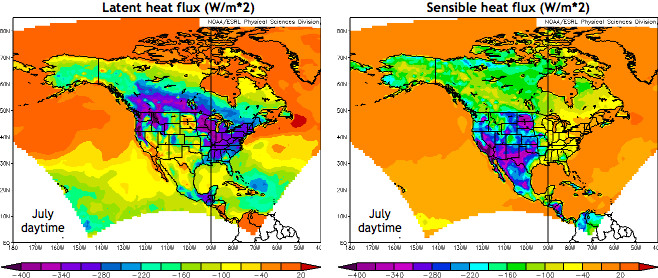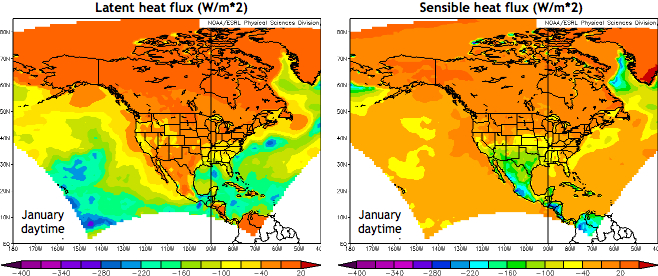
|

|


The surface energy budget
Daytime fluxes
Compare the sensible and latent heat maps for July daytime, below. You can see that sensible heat is relatively strong where latent heat is relatively weak, and vice versa. This gives you some insight into how different climates partition the incoming solar radiation. In arid regions like Mexico and the American southwest, the ground heats up considerably during the day, resulting in strong flows of heat from the land to the atmosphere. In humid regions, the energy absorbed by the surface is released through the evaporation of surface moisture, resulting in strong latent heat fluxes. The moisture could also be coming from irrigated farmland, which puts a lot of water in the ground and creates a strong difference in moisture content between the surface and the air.

On the other hand, during the day in January, there is less incoming solar radiation so the fluxes of energy are relatively weaker over land.

Next page -> nighttime fluxes
Links and resources
Daytime fluxes
Compare the sensible and latent heat maps for July daytime, below. You can see that sensible heat is relatively strong where latent heat is relatively weak, and vice versa. This gives you some insight into how different climates partition the incoming solar radiation. In arid regions like Mexico and the American southwest, the ground heats up considerably during the day, resulting in strong flows of heat from the land to the atmosphere. In humid regions, the energy absorbed by the surface is released through the evaporation of surface moisture, resulting in strong latent heat fluxes. The moisture could also be coming from irrigated farmland, which puts a lot of water in the ground and creates a strong difference in moisture content between the surface and the air.

On the other hand, during the day in January, there is less incoming solar radiation so the fluxes of energy are relatively weaker over land.

Next page -> nighttime fluxes
Links and resources
